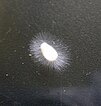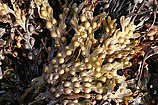Gyrista
| Gyrista | |
|---|---|
| Gyristan representatives (clockwise from top-left): diatoms, Develorapax .
| |
| Scientific classification | |
| Domain: | Eukaryota |
| Clade: | Diaphoretickes |
| Clade: | TSAR
|
| Clade: | SAR |
| Clade: | Stramenopiles |
| Phylum: | Gyrista Cavalier-Smith 1998[1]
|
| Subgroups[2][3] | |
| |
Gyrista is a phylum of
Ochrophyta, the parasitic Pseudofungi, and the recently described group of nanoflagellates known as Bigyromonada.[2] Members of this phylum are characterized by the presence of a helix or a double helix/ring system in the ciliary transition region.[1]
Systematics
Taxonomic history
Gyrista was first described in 1998 by
bicosoecids and labyrinthulomycetes, while the Ochrophyta, Pseudofungi and Bigyromonada remained as groups within Gyrista.[2]
Molecular phylogenetics
Gyrista was seen in 2017 as the sister group to phylum
A phylogenetic analysis in 2022 recovered a
paraphyletic:[5]
Stramenopiles
|
| ||||||||||||||||||||||||||||||
Classification
The 2018 revised taxonomy of Gyrista is the following,[2] with the inclusion of new ochrophyte classes described in 2020[6] and 2021:[7]
- Subphylum Bigyromonada Cavalier-Smith 1998
- Class DevelopeaAleoshin et al. ex Cavalier-Smith 2017 [=Bigyromonadea Cavalier-Smith 1997]
- Class Pirsonea Cavalier-Smith 2017[2]
- Class
- Subphylum Pseudofungi Cavalier-Smith 1986 [=Heterokontimycotina M.W. Dick 1976]
- Class HyphochytreaCavalier-Smith 1986 [=Hyphochytriomycota Whittaker 1969]
- Class OomycetesWinter in Rabenhorst 1879 [=Oomycota Arx 1967; Peronosporomycetes M.W. Dick 2001]
- Class
- Subphylum OchrophytinaCavalier-Smith 1995 [=Heterokontophyta van den Hoek et al. 1978; Stramenochromes Leipe et al. 1994]
- Infraphylum ChrysistaCavalier-Smith 1991
- Superclass Limnistia Cavalier-Smith 1996 emend. 2006
- Class EustigmatophyceaeHibberd & Leedale (1971)
- Class ChrysomonadeaSaville-Kent 1881 stat. nov. Pascher 1910 emend. Cavalier-Smith 2017 [=Chrysophyceae Pascher 1914]
- Class SynchromophyceaeHorn et al. 2007]
- Class
- Superclass RaphidoistiaCavalier-Smith 1986 orth. mut. 2006
- Class Raphidomonadea Chadefaud ex Silva 1980
- Subclass RaphidophycidaeCavalier-Smith 2013
- Subclass Raphopoda Cavalier-Smith 2013
- Subclass
- Class Raphidomonadea Chadefaud ex Silva 1980
- Superclass Fucistia Cavalier-Smith 1995
- Class Aurophyceae Cavalier-Smith 2013
- Subclass Aurearenophycidae Kai Yoshii Nakayama & Inouye 2008 (as Aurearenophyceae)[8] stat. nov. Cavalier-Smith 2013[9]
- Subclass Phaeothamniophyceae) stat. nov. Cavalier-Smith 2006
- Class Chrysomerophyceae Cavalier-Smith 1995
- Class Chrysoparadoxophyceae Wetherbee et al. 2019
- Class Phaeosacciophyceae R.A.Andersen L.Graf & H.S.Yoon 2020[6]
- Class Schizocladiophyceae Henry Okuda & Kawai 2003
- Class PhaeophyceaeKjellman 1891 [=Fucophyceae Warming 1884; Melanophyceae Rabenhorst 1863]
- Subclass Discosporangiophycidae
- Subclass Ishigeophycidae Silberfeld F. Rousseau & Reviers 2014[10]
- Subclass Dictyotophycidae Silberfeld F. Rousseau & Reviers 2014[10]
- Subclass Fucophycidae Cavalier-Smith 1986
- Subclass
- Class Heterokontae Luther 1899]
- Class Aurophyceae Cavalier-Smith 2013
- Superclass Limnistia Cavalier-Smith 1996 emend. 2006
- Infraphylum DiatomistaDerelle et al. ex Cavalier-Smith 2017
- Superclass Hypogyrista Cavalier-Smith 1995 stat. nov. 2006
- Class Dictyochophyceae Silva 1980 [=Dictyochia Haeckel 1894; Alophycidae Cavalier-Smith 2006]
- Subclass PedinelliaCavalier-Smith 1986 stat. nov. 2017 [=Actinochrysophyceae Cavalier-Smith 1995; Axodines]
- Subclass Pelagophyceae) ex Cavalier-Smith 2006
- ?Subclass Sulcophycidae Cavalier-Smith 2013 – ?Sulcochrysis[a]
- Subclass
- Class PinguiophyceaeKawachi et al. 2002
- Class Dictyochophyceae Silva 1980 [=Dictyochia Haeckel 1894; Alophycidae Cavalier-Smith 2006]
- Superclass KhakistaCavalier-Smith 2000 stat. nov. 2017
- Class Bolidophyceae
- Class Diatomeae[=Bacillariophyceae]
- Subclass Corethrophycidae Round & Crawford 1990
- Subclass Rhizosoleniophycidae Round & Crawford 1990
- Subclass Eucentricophycidae Cavalier-Smith 2000
- Subclass Bacillariophycidae [=Pennatia Pennatia Schütt 1896; =Pennatophycidae]
- Superclass Hypogyrista Cavalier-Smith 1995 stat. nov. 2006
- Ochrophytina incertae sedis
- Class Olisthodiscophyceae Barcytė Eikrem & M. Eliáš 2021[7]
- Class
- Infraphylum
Notes
- Olisthodiscophyceae which includes only the genus Olisthodiscus. The position of the genus Sulcochrysis remains uncertain due to a lack of DNA sequences.[7]
References




